|
|
Home →
Survival →
Navigation
Improvised Compass
by Rob Bicevskis
Page 1
Page 1
Page 2
Page 3
|
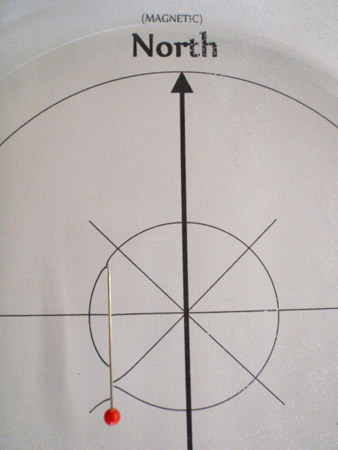 |
Introduction
The picture to the left is what it's all about - a magnetized needle suspended in some
way and pointing North.
Simple huh?
It's all explained in a video by Bear Grylls from his TV series Man vs. Wild:
HowStuffWorks Videos "Man vs Wild: Mexico Water Compass"
If you don't want to watch the video (or if it has moved) here's a summary:
Take a piece of wire, rub it in your hair, float it on some water and voila,
you have a compass.
|
|
|
MAKING IMPROVISED COMPASSES
"18-15. You can construct improvised
compasses using a piece of ferrous metal that can be needle-shaped or a flat
double-edged razor blade and a piece of thread or long hair from which to suspend
it. You can magnetize or polarize the metal by slowly stroking it in one
direction on a piece of silk or carefully through your hair using deliberate
strokes. ....... When suspended from a piece of nonmetallic string, or floated
on a small piece of wood, cork or a leaf in water, it will align itself with a
north-south line."
Quote taken from:
FM 3-05.70 (FM 21-76 US Army Survival Manual)
Field Manual Headquarters
No. 3-05.70 Department of the Army
Washington, DC, 17 May 2002
Section 18-8 |
|
To the left is an excerpt from the US Army's
Survival manual. It is another description of of how to create an Improvised Compass.
Or have a look at Tip #74 in:
101 Survival Tips: Strategies for Self-Reliance in Any Environment
By Department of the Army, Lyons Press
Published by Globe Pequot, 2006
ISBN 1599210010, 9781599210018
Which describes the same thing (in the same words)
Also on the internet, have a look at:
UNITED STATES MARINE CORPS
Mountain Warfare Training Center
Bridgeport, CA. 93517-5001
SUMMER SURVIVAL COURSE HANDBOOK
|
|
| |
| Wrong!?!
Wrong!?!
Wrong!?! |
An internet search on "improvised compass silk"
gives thousands of hits where the same procedure is described. (Often in exactly the same
words!)
I have read dozens of survival books where this is written down.
Clearly this must be a well known/understood phenomena that has stood the test of time.
Would it surprise you if I said that this is all wrong!?! |
|
| |
| |
|
I know what you're thinking at this point. Another crackpot is loose on the internet! How could
the US military be wrong about WMD? (That of course is Way-finding by Magnetic Direction!)
How could the video/TV episode by Bear Grylls be wrong? He is clearly showing that this works.
No lies on TV.
Ok then, what is really going on?
The rest of this article is divided into a few sections:
- Hypothesis about how this "myth" originated.
- Experimental results.
- Some improvised compasses including an original, novel, version (that does work!)
|
|
|
| Origins of the Improvised
Compass Myth |
| |
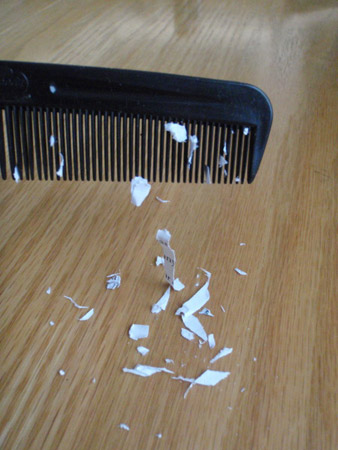 |
Many of us have some recollection of a science class where we
had rods of various materials and also a collection of things like silk, fur etc. By
suspending one of the rods, or mounting it on a pivot, we were able to make it move
towards or away from another rod which had been rubbed with the silk, fur etc. Do an
internet search on things like: "electrostatics, rods, silk."
We also probably have personal experience with rubbing a balloon on our hair and
having it stick to a wall or other object, or rubbing a comb through our hair and having
it pick up pieces of paper. Walking across a carpet and touching some other object is a
real wake-up to this phenomena.
The above experiments deal with electrostatics. The important point here is that the
suspended charged rods attract or repel each other. They are not responding to the
earth's magnetic field.
For more information, look up: Triboelectricity |
|
 |
On the other hand, we have the case of a
magnet which will attract ferromagnetic metals.
We could suspend a magnet from a string, or place it on a pivot, and it would align to
the earth's magnetic field - which is the same as a commercial compass.In this case,
we are dealing strictly with magnetic fields.
(A background note -the term "ferrous" metal often come up when talking about magnets.
There is a bit of a terminology issue here. The actual term should be "ferromagnetic."
Look it up for details. This is a missing detail in the Bear Grylls video. He just
mentions using a piece of wire. If the wire happens to be say, copper wire, then we have
no hope in succeeding. At least the US Army acknowledges the right type of metal, they
just have their terminology a bit mixed up.) |
|
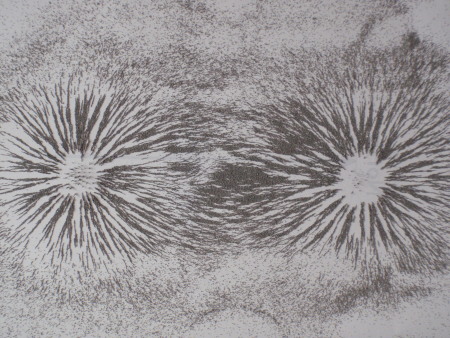 |
To better visualize the magnetic field around
a magnet, here is the classic picture of iron filings sprinkled over a piece of paper
with a magnet held below. This is sort of what the earth's magnetic field would look like
if you flattened it out. |
|
|
|
|
A bit of physics now. "Static" electric fields and magnetic fields are two different things and
do not interact. So, we can't pick up charged pieces of paper with a magnet, and we can't use an electrostatically charged object to attract to a magnetic field - which includes the earth's
magnetic field. So, even if we could have created a static electric field on our pin with the
piece of silk, this field will not interact with the earth's magnetic field - so no compass.
(Also, silk and metals aren't a very good combination for creating a static field in the first
place. Look up "Triboelectric series" for more information.) For the readers that are now
saying, "yeah, but I know that I can make an electromagnet with a battery and some wire." The
situation here is that moving electrons will create a magnetic field. With a battery you have a
circuit and a flow of electrons - hence a magnetic field. An electostatically charged object does
not have electrons in motion, hence no magnetic field. More on this later.
So what happened? I would guess that somewhere back in time someone wasn't listening in
science class. They got confused between electrostatics and magnetics. They published what they
thought was a way of making a compass. Over time, other authors read this procedure and dutifully
copied it into their works. Many years pass and we have the situation that we have today.
Probably half of the survival books contain this misleading information. A few more years pass,
and we have the internet. Now we have thousands of authors who can easily copy this information
and perpetuate the myth. Basically, it's too many people sitting down at typewriters and internet
terminals, and not enough people actually doing "dirt-time" and trying this stuff (.... or for
that matter listening in physics class!).
Ok, you say, "I can sort of follow this, but what about things like the Bear Grylls video? He
showed us that this works!?!" Good point. I don't know whether he intentionally faked the demo,
or whether he ended up with a "false positive." What do I mean by "false positive?" Think about
this: What if you took a pin/needle/piece of wire and it was already magnetized? You then rubbed
it with silk, or rubbed it through your hair and floated it on water. Wow, it would align to the
earth's N-S axis. Your compass would work, but for the wrong reasons. The compass would have
worked whether you had rubbed the indicator or not. You could have just a well stared at the pin
and talked it into being a magnet. The results would have been the same. When you get to the
experimental results section, you will see that this is indeed a plausible mechanism for the
perpetuation of the myth.
Let's Try It Words are fine, but in the end, repeatable
experimental results speak much more loudly. Here is what I tried: |
|
|
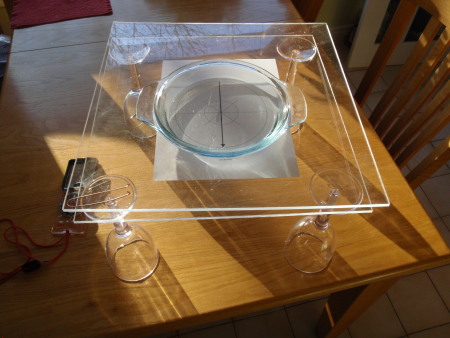 |
Step one was to create a test-bed. It
consisted of a piece of acrylic plastic that was placed on top of four wine glasses. The
intent here was to make sure that there was a surface that was far enough away from any
screws that might have been in the table and that could have affected the results. |
|
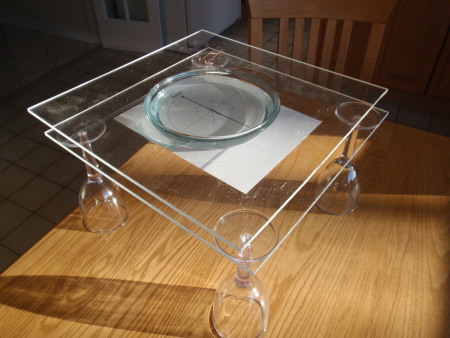 |
On top of the lower piece of plastic was a
glass pie plate that was partially filled with water. On top of that was another piece of
plastic. The top piece of plastic was to ensure that no air currents could affect the
results. |
|
 |
Under the pie plate was a piece of paper that
gave some reference lines and was aligned to magnetic north. |
|
 |
There are many ways to float a needle. Here a
slice of cork is being used. One can also use a leaf, piece of wood etc. |
|
 |
In order to remove as many variables as
possible I just floated needles on the water.
Why does this work? Look up "surface tension." Even better, search for "surface tension
floating needle."
To float my needles, I used a piece of copper wire. Copper is non-magnetic so any needles
that did have a magnetic field would not be attracted to the wire.
A plastic fork would work just as well. |
|
 |
A floating needle. Magnets can have
different strengths. A pin or needle that is "highly" magnetized will align to the N-S
line quickly. One with a weak field would align much more slowly. In order to gauge how
magnetized a needle was, I turned the floating needle perpendicular to the N-S axis and
then timed how long it took to turn parallel to the N-S axis. |
|
 |
I bought eight different types of pins and
needles from a variety of stores. I wanted to get a reasonable cross-section of pins and
needles. |
|
| Brand |
Sample A |
Sample B |
Sample C |
| A |
T32 |
T40 |
H5 |
| B |
NM |
T40 |
NM |
| C |
H7 |
T5 |
H3 |
| D |
T24 |
H5 |
T18 |
| E |
NM |
H40 |
NM |
| F |
NM |
NM |
NM |
| G |
H5 |
H25 |
H6 |
| H |
H35 |
H75 |
H50 |
|
The table to the left shows the results of the
first set of experiments.
The codes in the table are as follows:
T## means that the Tip of the pin pointed north. The ## is the number of seconds that it
took for the pin to rotate from being perpendicular to being parallel to the earth's
magnetic axis.
H## means that the Head of the pin pointed north. The ## is as above.
NM means Non-Magnetic. This means that over a period of two minutes there was no
observable bias towards the head or tip of the pin moving in any direction. |
|
|
|
|
The first experiment showed very interesting results. Out of 8 types of pins and needles, only
one brand proved to be totally non-magnetic. Of all of the samples tested, 17 of 24 (75%) showed a level of magnetism that allowed me to easily
determine the N-S axis.
What this means is that any pins or needles that you have are probably already magnetic!!
So, if you took one of the pins/needles from my sample, it is very likely that you wouldn't have
to do anything to them to use them as a compass. This goes back to my earlier comment about false
positives. Rubbing the already magnetized needles would be irrelevant. "Whoa" you say. Hold on a
minute. We still haven't proven that last sentence. You're right. So there are two things we can
try.
- Take the samples and rub them with silk to see if there is any difference.
- Rub the samples with fur and hair.
- Demagnetize the samples, test them, rub them with silk/fur/hair, then test them again.
A lot work, but it's a big myth to topple, so here goes... |
| |
|
On to next page ...
Page 1
Page 2
Page 3
|
| |
|
|
| |
|
|